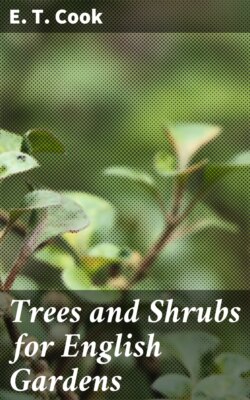Читать книгу Trees and Shrubs for English Gardens - E. T. Cook - Страница 35
На сайте Литреса книга снята с продажи.
TREES AND SHRUBS WITH FINE FRUITS
ОглавлениеTable of Contents
The most important of all the groups of trees and shrubs, for their fruit, is the one comprising the hardy species of the Rose order. This includes, of course, besides the Roses, such trees and shrubs as the Thorns, Crabs, and Cotoneasters. Among the Thorns (Cratægus) are many very handsome sorts giving variety in size and colour of the fruits. It is unfortunate that many of them fall early and get spoilt by birds. At the same time birds add so greatly to the delight of the garden that we may well overlook their depredations. By many, indeed, these fruiting trees will be considered worth growing for the encouragement they give to bird-life. It may be well to remind planters that a considerable number of these fruiting trees and shrubs bear male flowers on one plant, female on another. People are often at a loss to understand why their Sea Buckthorns or Aucubas or Skimmias do not fruit, when the simple reason is that the plants are all male (or pollen-bearing), or that the female ones have no males to fertilise them. As a general rule, if these shrubs are grouped, one male to eight or ten females is a proper proportion. As plants raised from seeds come in about equal proportions of both sexes, it is necessary to select the females and keep just sufficient males to pollenise them, in order that the full beauty of the species as a fruit-bearer may be obtained. With Skimmias and Aucubas the proper proportions can be obtained by means of cuttings.
The following hardy trees and shrubs are the most conspicuous for the beauty of their fruits:—
Arbutus Unedo.—A native of Western Ireland, has strawberry-like fruits of a bright-scarlet colour.
Ailantus glandulosa, a fine tree over 50 feet high, is very beautiful when covered with its red and yellow-winged fruits; there are male and female plants.
Aucubas, grown at first for their ornamental foliage merely, have latterly come into prominence as fruit-bearers; the female plants bear clusters of bright-red berries which remain long on the branches and are very attractive in winter.
Berberis.—The fruits of the Berberries are mostly covered with a plum-coloured bloom as in B. Aquifolium and B. Darwinii, but none of them is handsomer than our native B. vulgaris and its varieties. These have pendent racemes of fruits, varying in colour from the typical orange scarlet to white, purple, and black. B. Thunbergi coral-red, very beautiful.
Cratægus.—The finest of all the Thorns is C. Pyracantha, well named by the French "Buisson ardent." This shrub or small tree is valuable as a graceful evergreen, and when clothed (as it nearly always is in autumn) with its brilliant clusters of orange-red haws, it is one of the most beautiful objects in the garden. It is quite hardy in the open, but bears fruits more abundantly when planted against a wall. In that position also it is more easily protected from birds, which soon destroy the beauty of plants in the open. The variety Lælandi is distinct from the type, but hardier, and bears bright berries in abundance. The Cockspur Thorn (C. Crus-Galli) has several varieties, all producing pendent clusters of scarlet haws. The varieties like pyracanthifolia, with narrow leaves and flat-topped habit, are the best in this respect; they retain the fruits well into the winter, and are not eaten by birds so freely as many are. The haws of C. cordata, the Washington Thorn, are small, but a brilliant orange. C. punctata, C. Azarolus, and C. pinnatifida have the largest haws of any, and they are of a deep red, but fall early; the two first, however, are variable, and forms with yellow and other coloured haws belong to them. Those of C. macracantha are bright red, and in favourable years are so plentiful as to make the tree wondrously beautiful. C. coccinea and C. mollis have also red haws, larger than those of C. macracantha, but they fall soon after they are ripe. The Common Hawthorn is pretty, but more noteworthy is its variety aurea, with bright-yellow haws. In C. oliveriana they are black. The Tansy-leaved Thorn (C. tanacetifolia) has large yellow fruits, not badly flavoured, and with the fragrance of Apples. C. orientalis has haws of a bright sealing-wax red, but in its variety sanguinea they are of a deeper shade.
